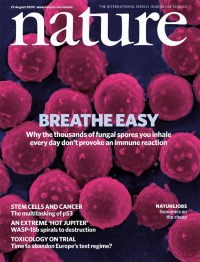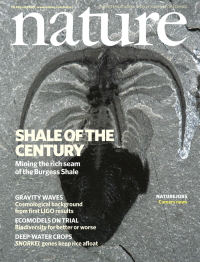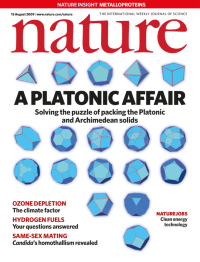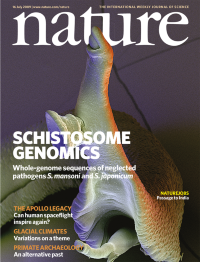Volume 460
-
No. 7259 27 August 2009
The cover shows a scanning electron micrograph of the spores or conidia of Aspergillus fumigatus (by S. Guadagnini, J. M. Panaud and A. Beauvais), one of the many fungal species contributing to the thousands of fungal spores that we inhale daily. The reason why these spores do not normally elicit an immune response has now been found, in the form of a hydrophobic layer of rodlet proteins covering the conidial surface.
-
No. 7258 20 August 2009
The cover shows a Burgess Shale fossil of Marrella splendens, one of the first species found by Charles Doolittle Walcott (photo: Royal Ontario Museum/J. B. Caron). In Opinion page 952 this week Desmond Collins revisits the story of Walcotts discovery of the shales, 100 years ago this month.
-
No. 7257 13 August 2009
The structures on the cover are the 18 classic geometric shapes, the Platonic and Archimedean solids. Though these shapes have been around since the time of the Ancient Greeks, little is known about the densest arrangements that they can adopt during packing. Salvatore Torquato and Yang Jiao now conjecture that the densest packings of Platonic and Archimedean solids with central symmetry are given by their corresponding densest lattice packings.
Insight
-
No. 7256 6 August 2009
The secondary structure of a complete HIV-1 RNA genome has been determined by Kevin Weeks and colleagues, based on analysis of authentic HIV RNA extracted from infectious virions. Numerous highly structured motifs were discovered some are shown on the cover and functions can be inferred for many of these motifs. Cover image courtesy of Lars Sahl.
-
No. 7255 30 July 2009
A dye measurement on a Mastigias sp. jellyfish in Jellyfish Lake, Palau. Kakani Katija and John Dabiri used data from experiments like this, combined with a new theoretical model, to show that the contribution of living organisms to ocean mixing via a mechanism described by Sir Charles Darwin - grandson of the Charles Darwin - is the same order of magnitude as that of winds and tides. Photo credit: Kakani Katija.
-
No. 7254 23 July 2009
The cover shows simultaneous views of aurorae in the Northern Hemisphere (top, from IMAGE-WIC) and the Southern Hemisphere (from the Polar VIS Earth Camera). Analysis of these images shows that the common assumption that the aurora borealis (in the Northern Hemisphere) and aurora australis (in the south) are mirror images of each other is not always the case. The authors thank S. B. Mende for the use of IMAGE FUV WIC data and J. B. Sigwarth for the use of Polar VIS Earth Camera data.
-
No. 7253 16 July 2009
The whole genome sequences of the blood flukes Schistosoma mansoni and Schistosoma japonicum, two of the three major pathogens that cause the neglected tropical disease schistosomiasis, are reported in this issue by the Schistosoma japonicum Genome Sequencing and Functional Analysis Consortium and Matthew Berriman and colleagues. The photomicrograph on the cover, by David Scharf (http://www.scharfphoto.com/), shows a mated pair of S. mansoni flukes at approximately x265, with the slender female emerging from the lower part of the male.
-
No. 7252 9 July 2009
Chromosomal instability (CIN) an increased rate of gain or loss of whole chromosomes is a hallmark of many cancers and correlates with the presence of extra centrosomes. Previously the subject of much debate, this week David Pellman and colleagues use long-term live-cell imaging to define the mechanism linking extra centrosomes to CIN. The cover shows a transient multipolar spindle intermediate in a human cell with extra centrosomes. Microtubules are shown red, centrosomes green and chromosomes white. [Cover image: Neil J. Ganem]
-
No. 7251 2 July 2009
A cardiovascular progenitor population from human fetal hearts capable of generating all the main cardiac cell types is described this week by Kenneth Chien and colleagues. Despite glimpses of success, the road to cardiac regenerative medicine is proving a long haul [see News, p. 18]. The cover image, by Paul R. Riley, illustrating a heart wrapped in a layer of regenerating cells, is from a study showing that thymosin β4 guides progenitor cells from the outer layer of the heart to tissue repair sites ().









